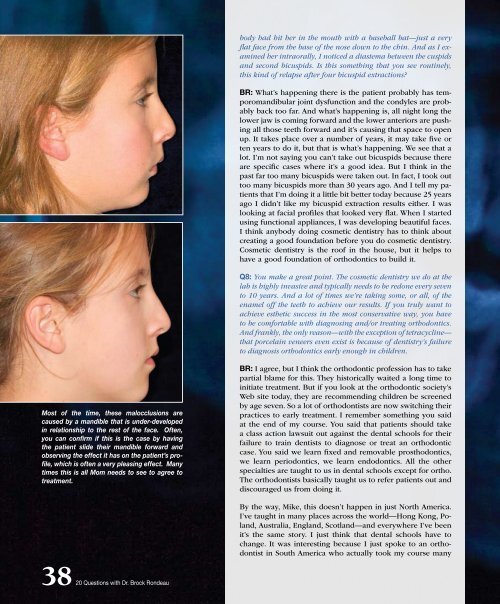Chairside - Glidewell Dental Labs
Chairside - Glidewell Dental Labs
Chairside - Glidewell Dental Labs
Create successful ePaper yourself
Turn your PDF publications into a flip-book with our unique Google optimized e-Paper software.
Most of the time, these malocclusions are<br />
caused by a mandible that is under-developed<br />
in relationship to the rest of the face. Often,<br />
you can confirm if this is the case by having<br />
the patient slide their mandible forward and<br />
observing the effect it has on the patient’s profile,<br />
which is often a very pleasing effect. Many<br />
times this is all Mom needs to see to agree to<br />
treatment.<br />
38<br />
20 Questions with Dr. Brock Rondeau<br />
body had hit her in the mouth with a baseball bat—just a very<br />
flat face from the base of the nose down to the chin. And as I examined<br />
her intraorally, I noticed a diastema between the cuspids<br />
and second bicuspids. Is this something that you see routinely,<br />
this kind of relapse after four bicuspid extractions?<br />
BR: What’s happening there is the patient probably has temporomandibular<br />
joint dysfunction and the condyles are probably<br />
back too far. And what’s happening is, all night long the<br />
lower jaw is coming forward and the lower anteriors are pushing<br />
all those teeth forward and it’s causing that space to open<br />
up. It takes place over a number of years, it may take five or<br />
ten years to do it, but that is what’s happening. We see that a<br />
lot. I’m not saying you can’t take out bicuspids because there<br />
are specific cases where it’s a good idea. But I think in the<br />
past far too many bicuspids were taken out. In fact, I took out<br />
too many bicuspids more than 30 years ago. And I tell my patients<br />
that I’m doing it a little bit better today because 25 years<br />
ago I didn’t like my bicuspid extraction results either. I was<br />
looking at facial profiles that looked very flat. When I started<br />
using functional appliances, I was developing beautiful faces.<br />
I think anybody doing cosmetic dentistry has to think about<br />
creating a good foundation before you do cosmetic dentistry.<br />
Cosmetic dentistry is the roof in the house, but it helps to<br />
have a good foundation of orthodontics to build it.<br />
Q8: You make a great point. The cosmetic dentistry we do at the<br />
lab is highly invasive and typically needs to be redone every seven<br />
to 10 years. And a lot of times we’re taking some, or all, of the<br />
enamel off the teeth to achieve our results. If you truly want to<br />
achieve esthetic success in the most conservative way, you have<br />
to be comfortable with diagnosing and/or treating orthodontics.<br />
And frankly, the only reason—with the exception of tetracycline—<br />
that porcelain veneers even exist is because of dentistry’s failure<br />
to diagnosis orthodontics early enough in children.<br />
BR: I agree, but I think the orthodontic profession has to take<br />
partial blame for this. They historically waited a long time to<br />
initiate treatment. But if you look at the orthodontic society’s<br />
Web site today, they are recommending children be screened<br />
by age seven. So a lot of orthodontists are now switching their<br />
practices to early treatment. I remember something you said<br />
at the end of my course. You said that patients should take<br />
a class action lawsuit out against the dental schools for their<br />
failure to train dentists to diagnose or treat an orthodontic<br />
case. You said we learn fixed and removable prosthodontics,<br />
we learn periodontics, we learn endodontics. All the other<br />
specialties are taught to us in dental schools except for ortho.<br />
The orthodontists basically taught us to refer patients out and<br />
discouraged us from doing it.<br />
By the way, Mike, this doesn’t happen in just North America.<br />
I’ve taught in many places across the world—Hong Kong, Poland,<br />
Australia, England, Scotland—and everywhere I’ve been<br />
it’s the same story. I just think that dental schools have to<br />
change. It was interesting because I just spoke to an orthodontist<br />
in South America who actually took my course many

















